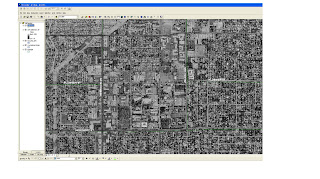1. What are some advantages and disadvantages of using digital spatial data? According to Bolstad, some advantages include that many features have already been mapped and converted to digital data; "many of the data help provide public services such as safety, helath, transportation, water, and energy. One disadvantage is that sometimes a person has to pay inorder to obtain some of these data.
2. What are the most important questions you must ask before using already-developed spatial data? Who collected the data and for what purposes.
3. How do DOQs differ from regular photographs? Digital Orthophoto Quadrangles are scanned photographic images that have been corrected for distortions due to camera tilt, terrain displacement, and other factors.
4. Three existing data sets:
c. Digital Flood Plain Data: Used to reduce physical and financial damage in case of floods; created by The Federal Emergency Management Agency.
II.
2. a. What are the names of the feature datasets in the geodatabase?
1. Basemap
2. Hydrology
b. What are the names of the feature classes in the hydrology dataset?
1. NHDFlowline
2. NHDPoint
3. NHDWaterbody
4. Watersheds
c. For each one of the feature classes you just listed, describe whether it is a polygon, line or point layer.
1. NHDFlowline: line
2. NHDPoint: point
3. NHDWaterbody: polygon
4. Watersheds: polygon
3. a. Is topoq24.shp a raster or vector layer? Vector digital data.
b. What is the GIS data format of topoq24.shp? Shapefile.
c. Is there metadata associated with topoq24.shp? Yes.
d. What is the GIS data format of the NHDFlowline layer? Personal Geodatabase Feature Class
e. Is there metadata associated with NHDFlowline? Yes.
f. What are 3 keywords used to describe the NHDFlowline layer? River, Hydrography, Stream.
g. Who created the NHDFlowline layer? U.S. Geological Survey in cooperation with U.S. Environmental Protection Agency, USDA Forest Service, and other Federal, State and local partners.
4. Is there still metadata associated with the layer? Yes.
6. In the USGS_QD_ID field, find the value that corresponds to the Canoga Park QUAD_NAME. What is it? 34118-B5.
a. The National Hydrologic Dataset: Contains digital spacial data about surface waters including rivers, streams, canals, ditches, lakes, ponds, springs, and wells; produced by the Environmental Protection Agency.
b. The National Wetlands Inventory: contains location and condition of wetlands; produced by the US Fish and Wildlife Service.
7. The DOQQ is black and white.
8.

3. How do DOQs differ from regular photographs? Digital Orthophoto Quadrangles are scanned photographic images that have been corrected for distortions due to camera tilt, terrain displacement, and other factors.
4. Three existing data sets:
c. Digital Flood Plain Data: Used to reduce physical and financial damage in case of floods; created by The Federal Emergency Management Agency.
II.
2. a. What are the names of the feature datasets in the geodatabase?
1. Basemap
2. Hydrology
b. What are the names of the feature classes in the hydrology dataset?
1. NHDFlowline
2. NHDPoint
3. NHDWaterbody
4. Watersheds
c. For each one of the feature classes you just listed, describe whether it is a polygon, line or point layer.
1. NHDFlowline: line
2. NHDPoint: point
3. NHDWaterbody: polygon
4. Watersheds: polygon
3. a. Is topoq24.shp a raster or vector layer? Vector digital data.
b. What is the GIS data format of topoq24.shp? Shapefile.
c. Is there metadata associated with topoq24.shp? Yes.
d. What is the GIS data format of the NHDFlowline layer? Personal Geodatabase Feature Class
e. Is there metadata associated with NHDFlowline? Yes.
f. What are 3 keywords used to describe the NHDFlowline layer? River, Hydrography, Stream.
g. Who created the NHDFlowline layer? U.S. Geological Survey in cooperation with U.S. Environmental Protection Agency, USDA Forest Service, and other Federal, State and local partners.
4. Is there still metadata associated with the layer? Yes.
6. In the USGS_QD_ID field, find the value that corresponds to the Canoga Park QUAD_NAME. What is it? 34118-B5.
a. The National Hydrologic Dataset: Contains digital spacial data about surface waters including rivers, streams, canals, ditches, lakes, ponds, springs, and wells; produced by the Environmental Protection Agency.
b. The National Wetlands Inventory: contains location and condition of wetlands; produced by the US Fish and Wildlife Service.
7. The DOQQ is black and white.
8.

10.

12. The layer is not showing up.
No comments:
Post a Comment